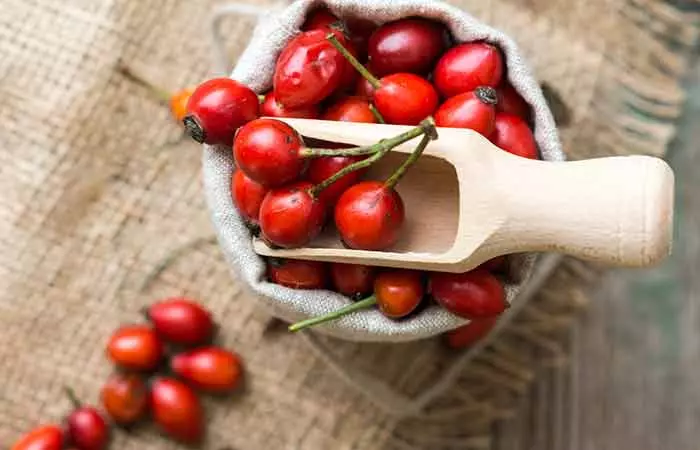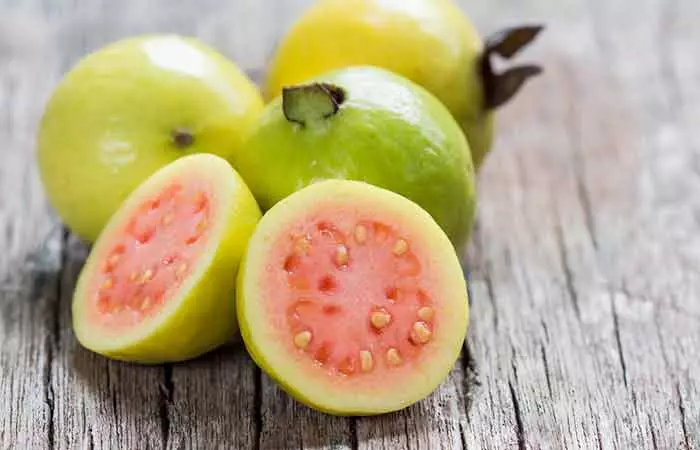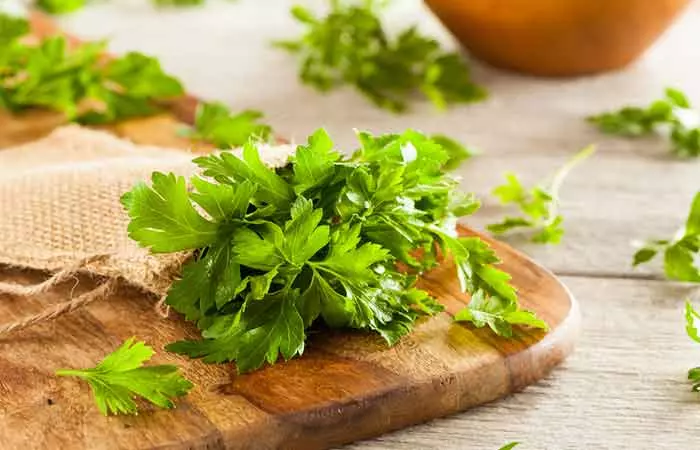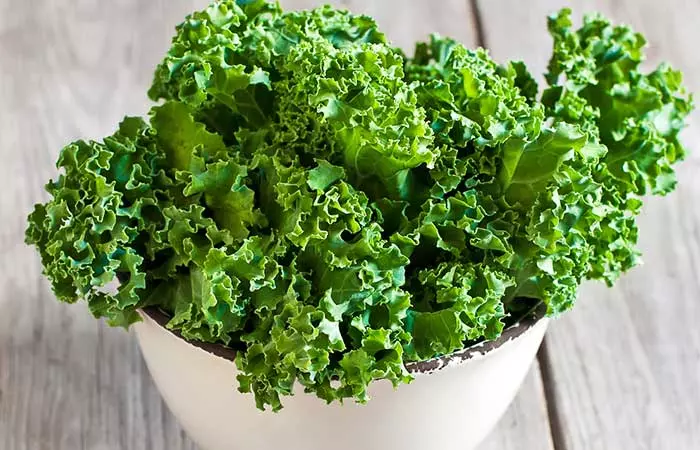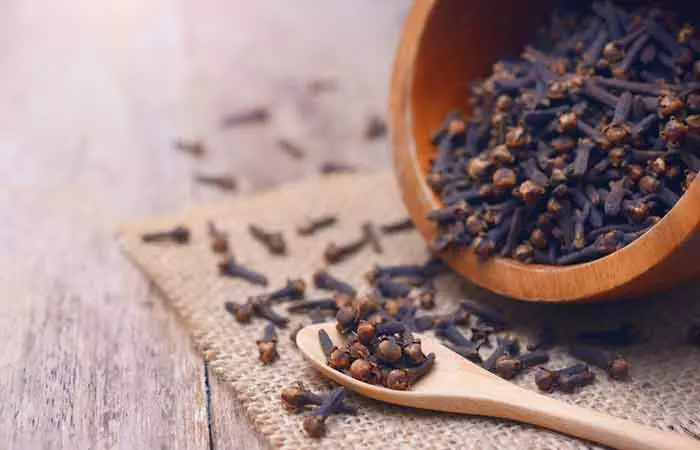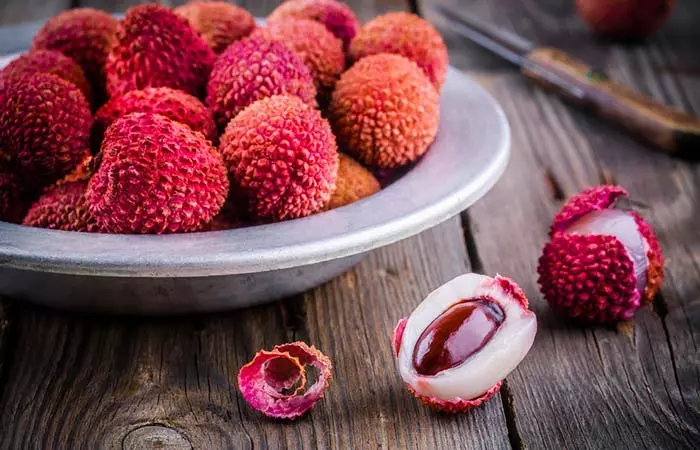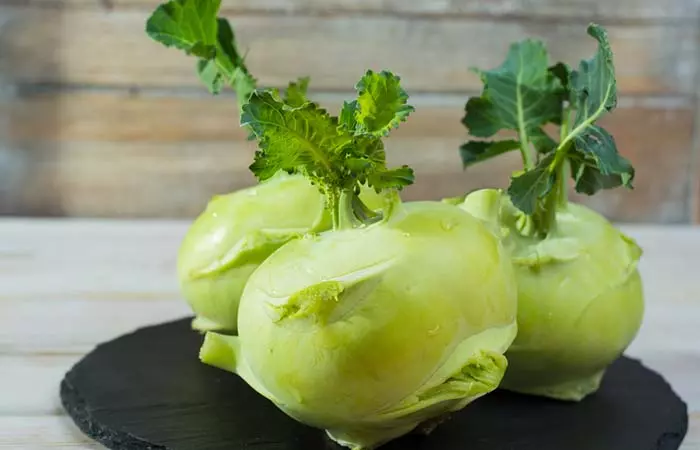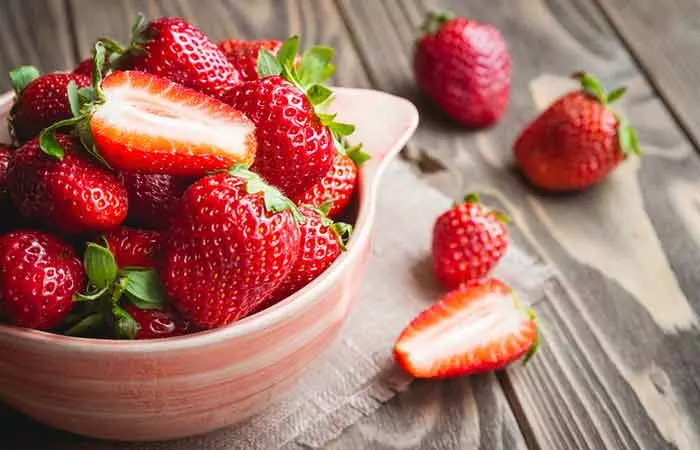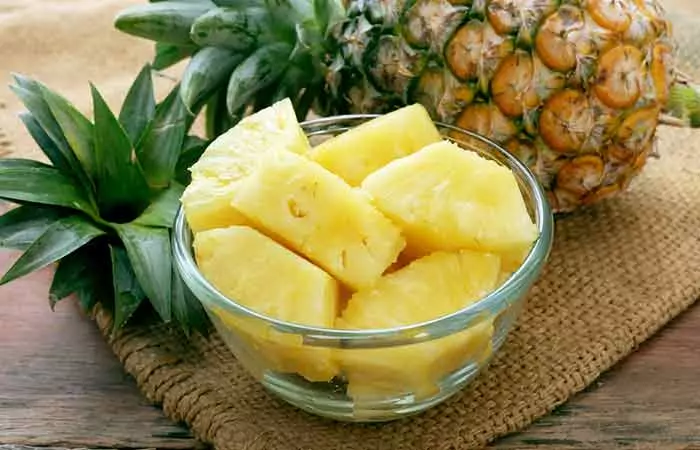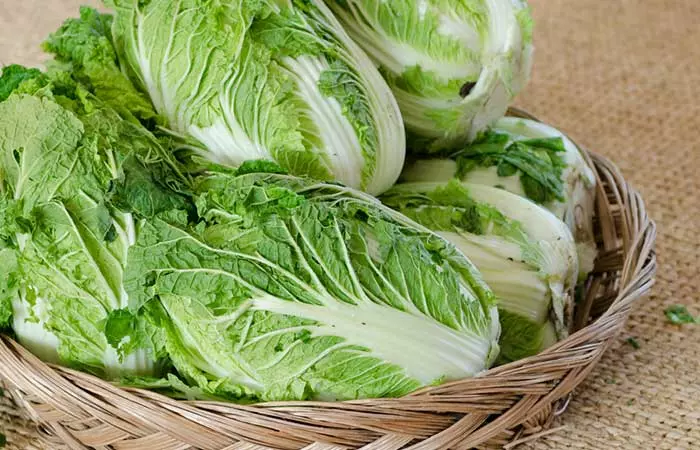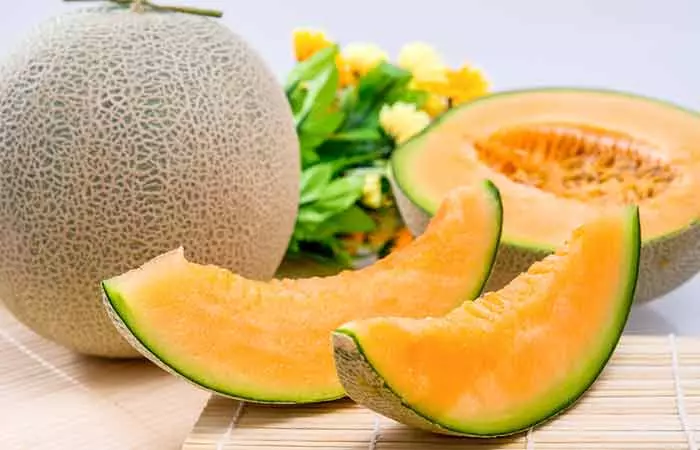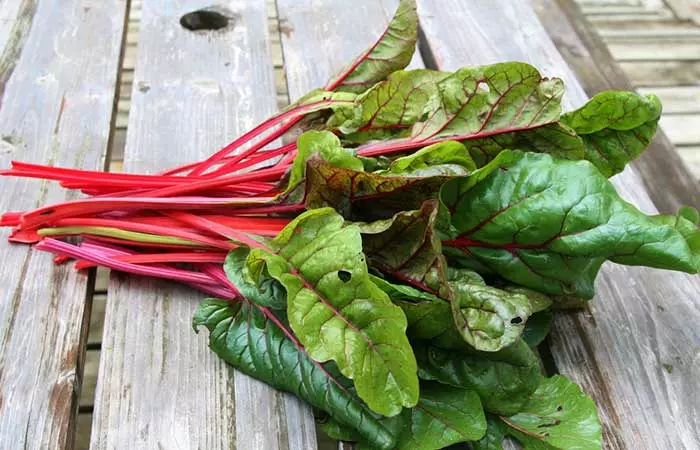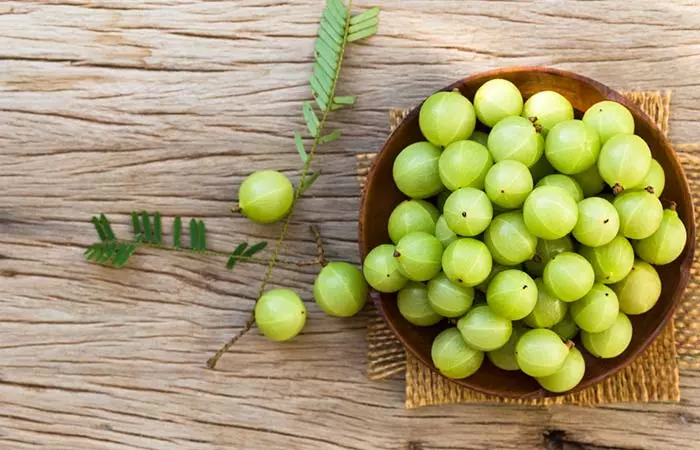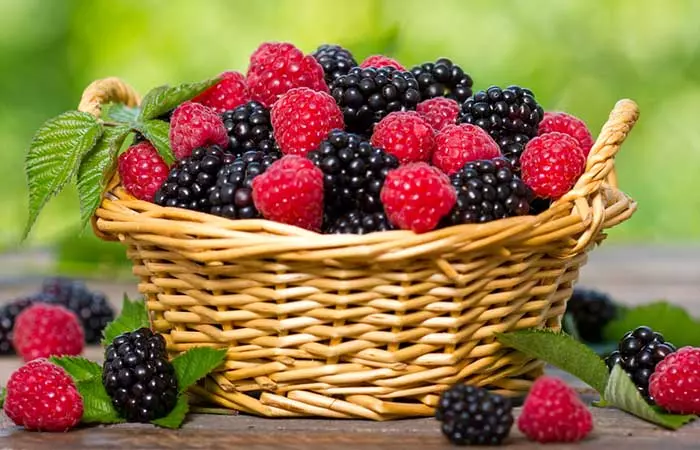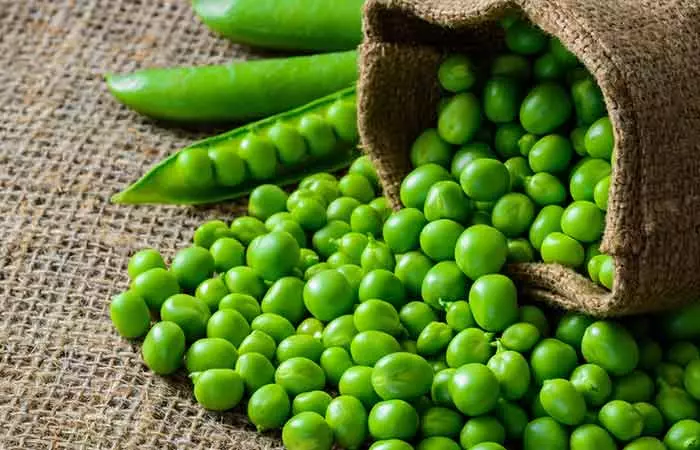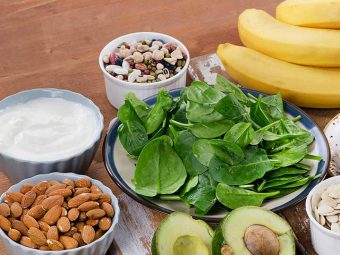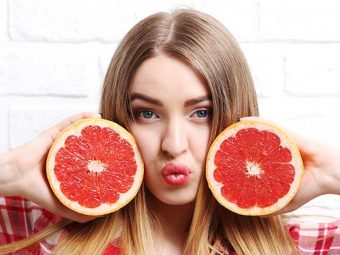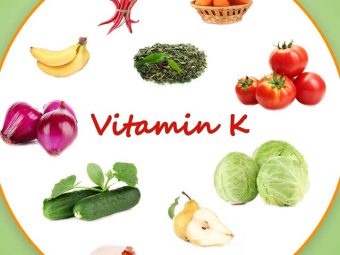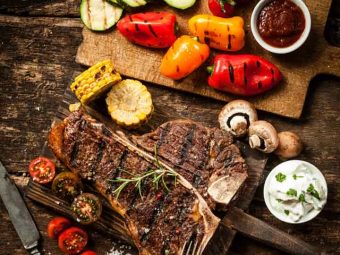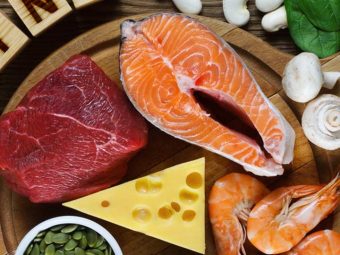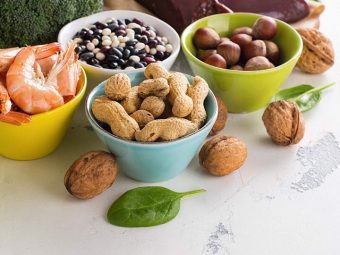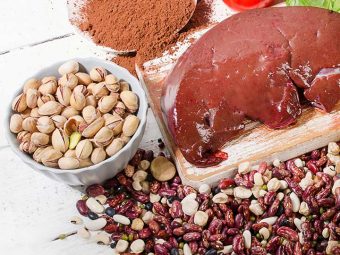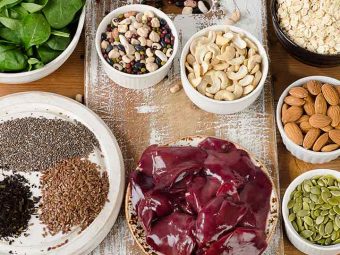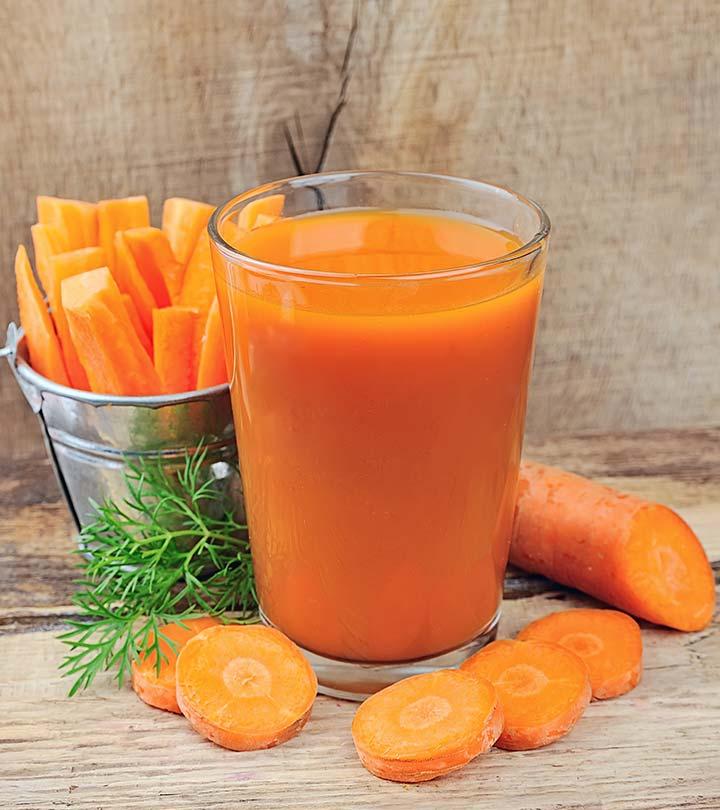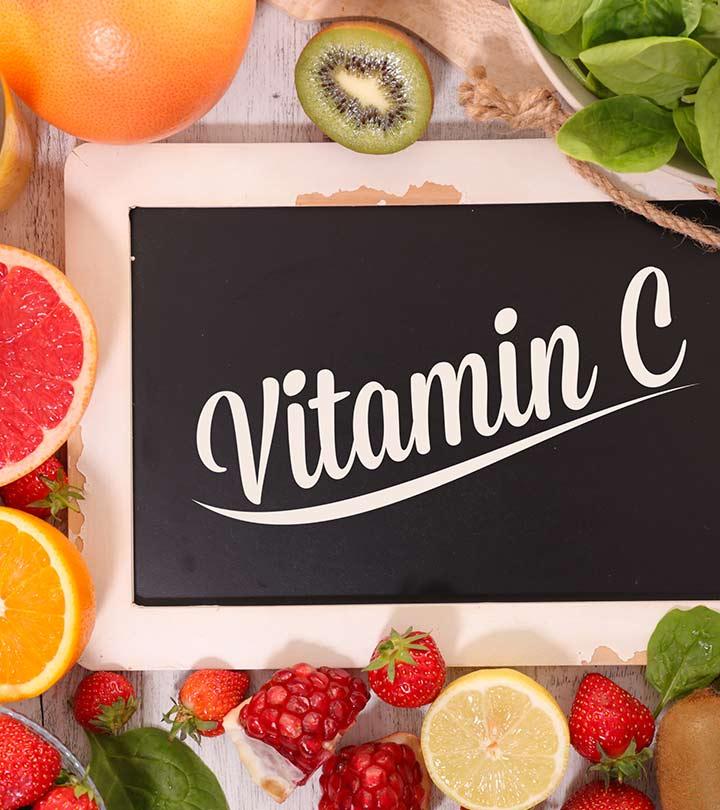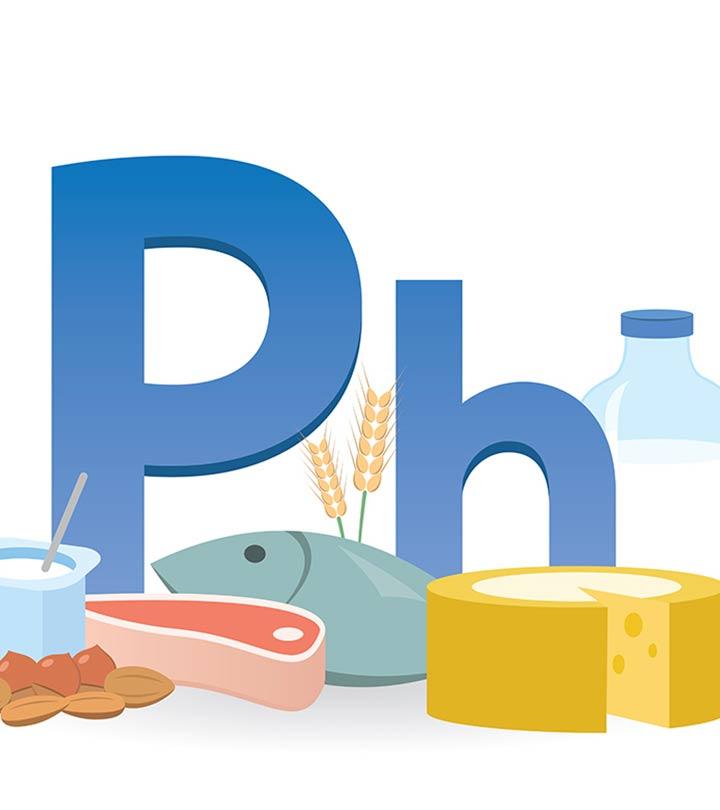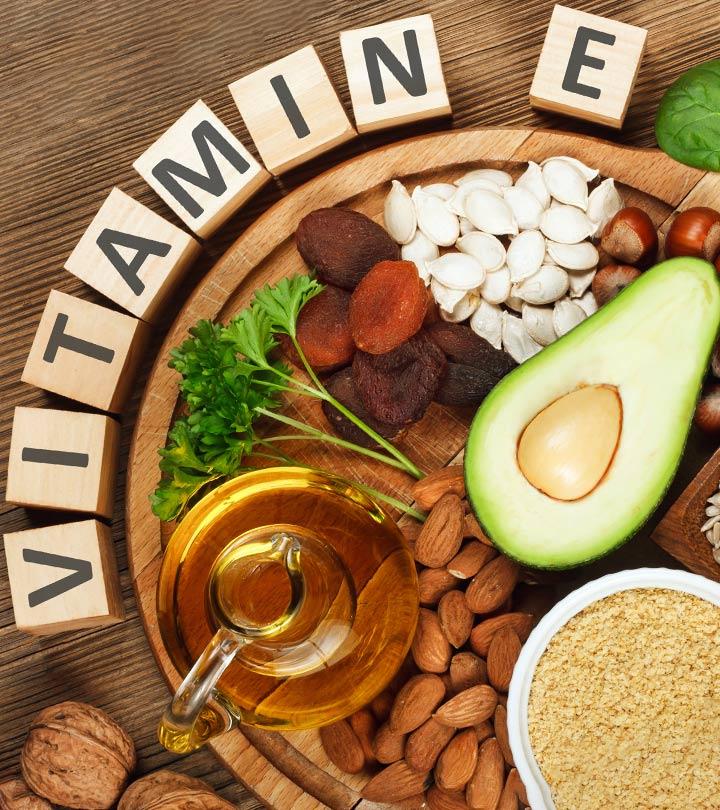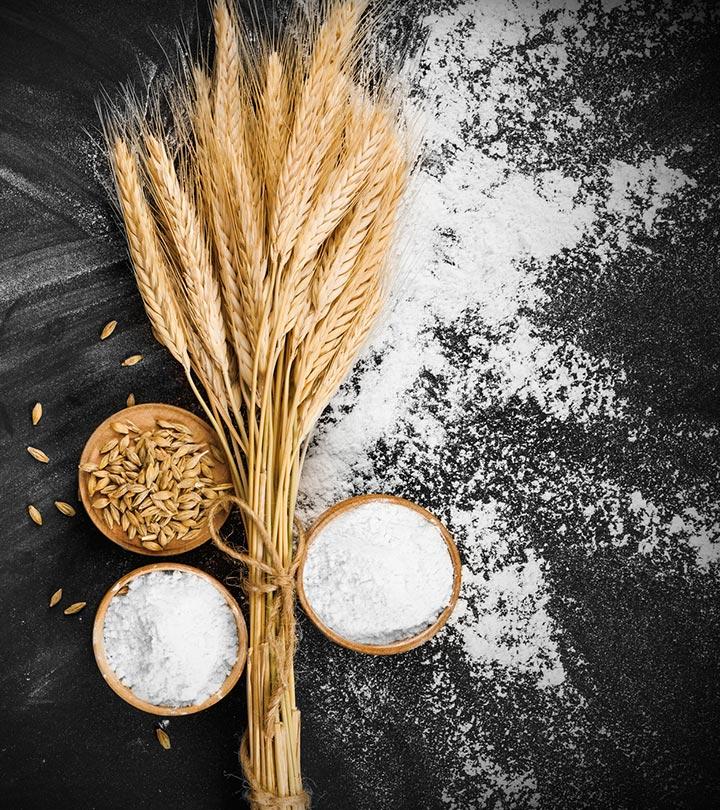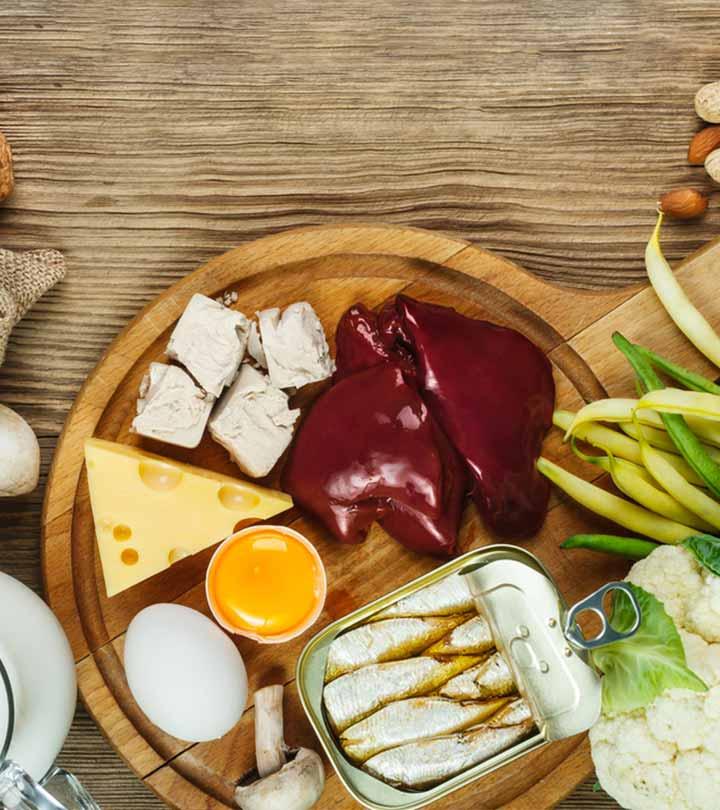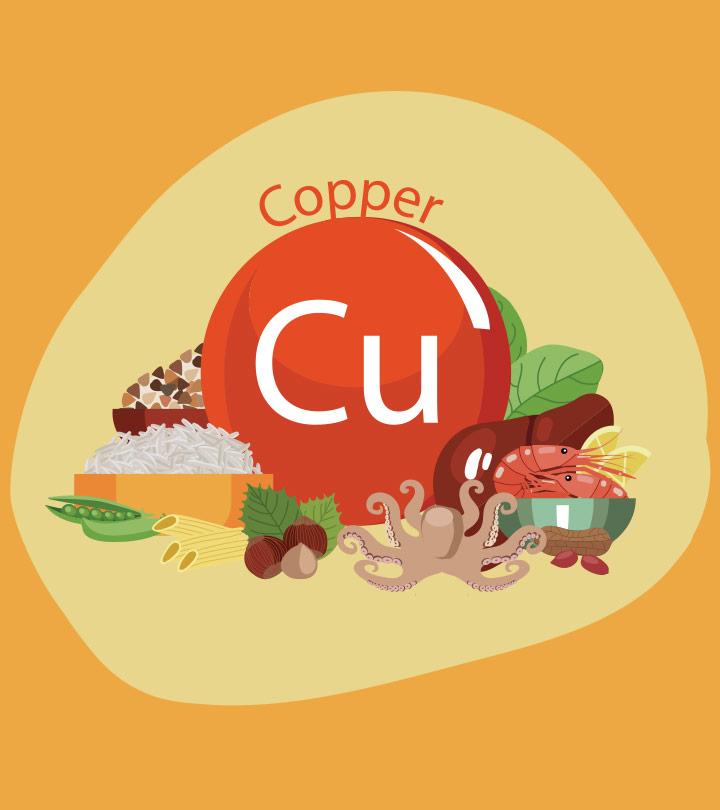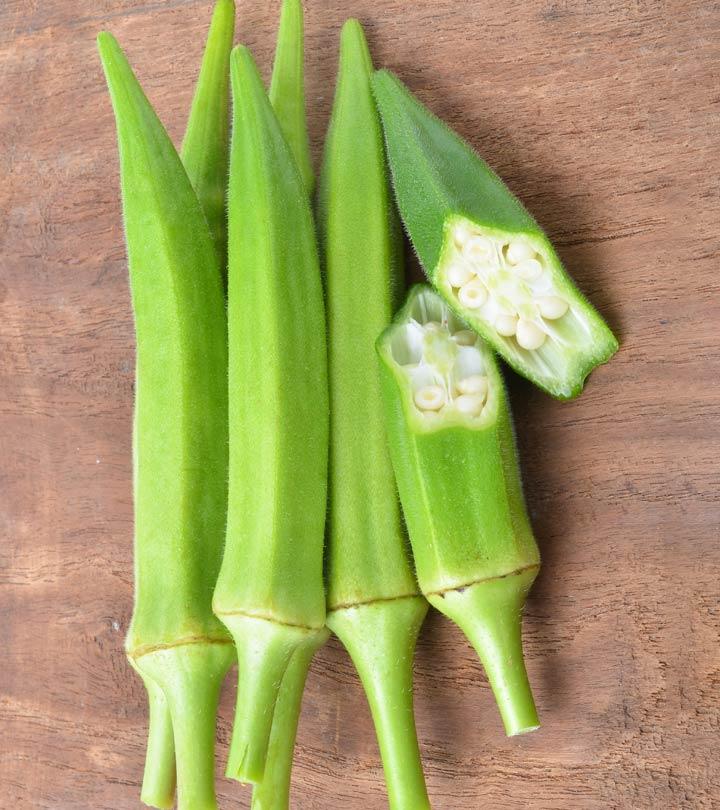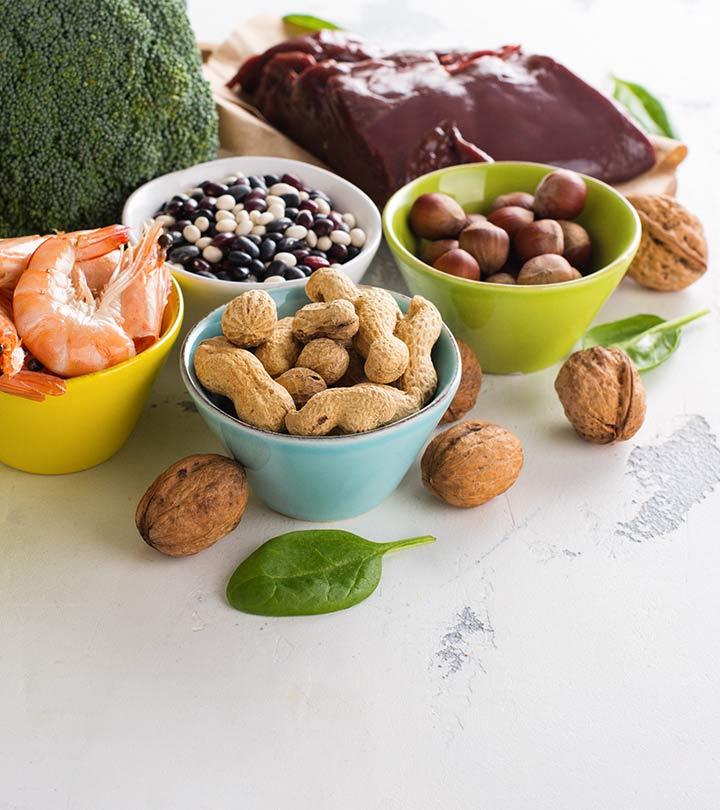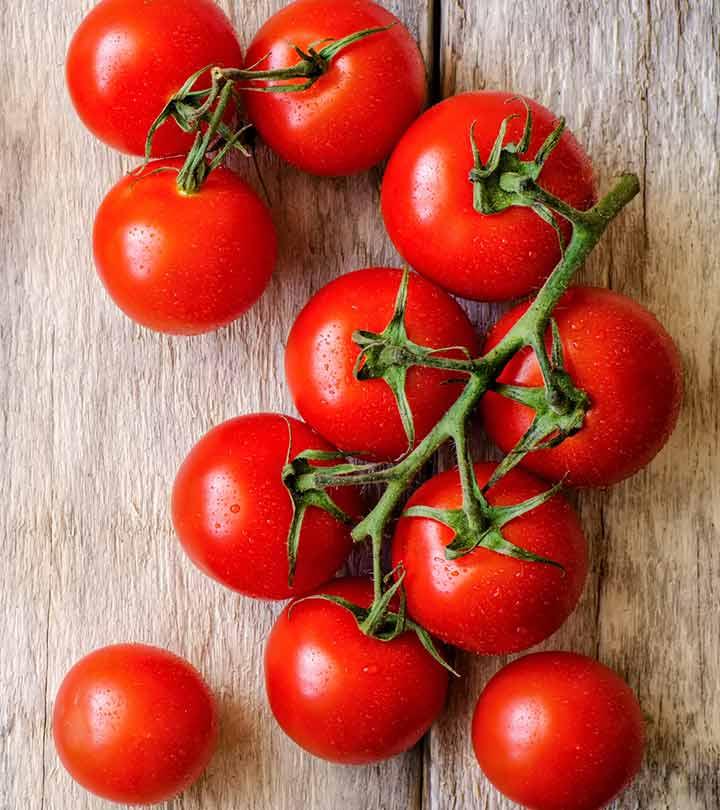Top 40 Vitamin C Foods To Include In Your Diet
All of these foods ensure you meet the recommended daily vitamin C intake.
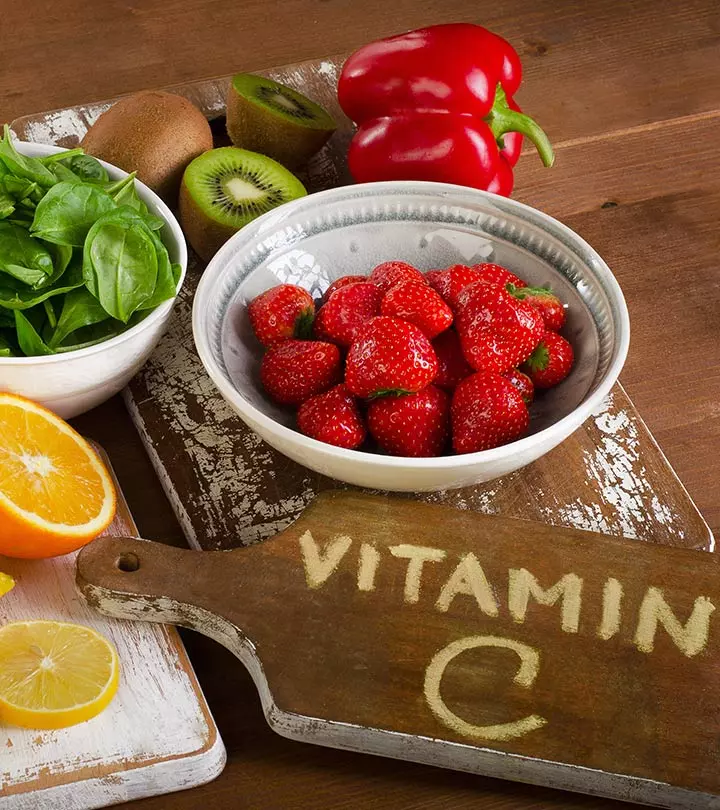
Image: Shutterstock
Ascorbic acid, popularly known as vitamin C, is a major antioxidant that plays a vital role in many bodily functions (1). Including vitamin C foods in your diet is a great way to boost your consumption of this nutrient, rather than relying on supplements. Along with scavenging free radicals, vitamin C can also help in cutting down the risk of cancer, synthesize collagen and some neurotransmitters, strengthen the bones, improve iron absorption, and metabolize protein (2), (3).
Unfortunately, the human body cannot synthesize this vital nutrient (4). To meet its daily recommended intake, which is 90 mg for men and 75 mg for women per day, you should include foods rich in vitamin C in your diet regularly (5).
When we talk about foods rich in this vitamin, many people think about citrus foods. But there is a wide variety of other foods which you can include other than citrus fruit in your diet to boost your vitamin C levels. Learn what they are from the article below.
But first, let us discuss a few interesting facts about Vitamin C.
In This Article
What Is Vitamin C?
Vitamin C, a water-soluble vitamin, is a small carbohydrate molecule, first identified by Albert von Szent Györgyi in 1920. He found that it was able to cure scurvy, a life-threatening condition caused due to a long duration of nonconsumption of fruits and vegetables. This scurvy curing molecule was named vitamin C, and the C stands for ascorbic acid as “ascorbic” means anti-scurvy. Vitamin C is naturally found in various foods and is an essential nutrient for both animals and plants (6). However, it cannot be synthesized by humans, primates, guinea pigs, birds, fish, and some bats. This is because one of the genes coding an enzyme (I-gluconolactone oxidase) required for vitamin C synthesis evolved into a nonfunctional gene.Therefore, humans need to depend on fruits and veggies for vitamin C and protect themselves from various diseases.
 Trivia
TriviaScurvy is no longer that prevalent. So, why is vitamin C consumption essential? Well, here’s your answer.
Why Is Vitamin C Important?
Vitamin C or ascorbic acid is an electron donor. After donating an electron to a recipient molecule, it becomes ascorbate, which is an essential cofactor for various enzymatic reactions in the body (7). When there’s a deficiency of vitamin C, the lack of cofactor prevents the reactions from taking place, which ultimately leads to weak immunity, weak bones, infections, skin problems, poor wound healing, joint pain, depression, fatigue, inflammation, bleeding gums, scurvy, and anemia (8). So, it is clear that vitamin C is crucial to maintain a healthy body and strong immunity.
A study conducted on more than 13,000 European men and women aged 42–82 found that the fat-free mass% and fat-free mass standardized by BMI measures were higher in people with enough vitamin C levels than in those with low vitamin levels — 3.4% and 3.9% in women and 1.6% and 2.0% in men respectively.
 Trivia
TriviaMain Idea – Include vitamin C in your daily diet to prevent most diseases and lead a healthy life.
Here are the 39 vitamin C-rich foods that you must include in your diet.
40 High Vitamin C Foods List
Check out here some of the best foods with high vitamin C in detail. Here we list out what are the best vitamin c fruits and vegetables.
1. Rose Hips
| Name | Vitamin C Content | Serving Size | DV% |
| Rose Hips | 426 mg | 100 g | 710 |
Rose hip or rose haw is an accessory fruit of the rose plant that is mostly used to prepare jams, jellies, syrups, herbal teas, wines, marmalade, and rose hip soup. It is one of the top foods rich in vitamin C – 100 g serving of rose hips contains 426 mg of vitamin C (9).
How To Include In Your Diet
You can have rose hip tea or rose hip soup or prepare rose hip jam, jelly, or rose hip crackers. Or you can add them to your ice cream or cakes.
Anita, a blogger, shared that you need to process rose hips before making tea by topping and tailing them, cutting them in half, and deseeding them. She states in her blog, “I had two kinds of rose hips–the long, orange kind (like chili peppers!) and the round, deep red ones. The orange ones were easier to process because they were softer with less seed (i).” She adds, “Boiling the hips for 10 minutes (which would have softened the red rose hips as well) is what is recommended, but I thought my tea tasted just dandy.”
2. Green Chili
| Name | Vitamin C Content | Serving Size | DV% |
| Green Chili, Hot | 242 mg | 100 g | 404 |
Surprise! Green chilies is considered one of the best vitamin C food sources than limes, oranges, and lemons. Just 100 g of green chilis contains 242 mg of vitamin C, and 1 green chili contains 109 mg of vitamin C (10). That’s good news for those who love consuming it.
How To Include In Your Diet
You can add a little chopped green chili to your salad to give it a hint of spiciness. Add green chilis to curries or stews. You can also make pickle and have it as a condiment. Remember, if you cannot tolerate the heat of green chilis or suffer from IBSi XIrritable bowel syndrome, an intestinal condition that causes constipation, diarrhea, flatulence, and stomach pain. /IBD, stomach ulcer, or had a recent intestinal surgery, please avoid consuming anything spicy, and that includes green chilis.
3. Guava
| Name | Vitamin C Content | Serving Size | DV% |
| Guava | 228.3 mg | 100 g | 381 |
The ripe and aromatic guavas are one of the richest sources of vitamin C in the fruits category, with 100 g of the fruit containing 228.3 mg of vitamin C, or 1 guava containing about 125 mg vitamin C (11). Hence, if you consume one guava today, you do not have to worry about your vitamin C intake for the next day as well. Here are the various ways you can include it in your daily diet.
How To Include In Your Diet
Apart from consuming a guava as it is, you can add ripe guava slices to a salad made with cucumber, beetroot, carrot, and apples. You can also drink freshly pressed guava juice with a dash of lime juice and a pinch of pink Himalayan salt. You may also spread a teaspoon of guava jelly on your toast.
4. Yellow Bell Pepper
| Name | Vitamin C Content | Serving Size | DV% |
| Yellow Bell Pepper | 183 mg | 100 g | 306 |
Yellow bell pepper is considered one of the highest vegetables high in vitamin C – 183 mg of vitamin C in 100 g, and 1 large yellow bell pepper contains 342 mg vitamin C (12). You must consume this vegetable to boost your immunity and make your meals more colorful. Here’s how you can include in your daily diet.
How To Include In Your Diet
Add slices of yellow bell pepper to your salad, sandwich, wraps, etc. You can also add yellow bell pepper cubes to pasta or use it in Asian or Mexican cuisines. You can also stuff it with chopped mushrooms or chickpeas or any vegetable of your choice and bake it to make a super tasty and healthy meal.
5. Parsley
| Name | Vitamin C Content | Serving Size | DV% |
| Parsley | 133 mg | 100 g | 222 |
This humble herb contains highest amount of vitamin C, with 100 g of it containing 133 mg of vitamin C, and 1 tablespoon of it containing 5 mg of vitamin C (13). It not only adds flavor and taste to your food but also helps boost your immunity. So, start including parsley in your daily diet from now on. Here are the various ways to do that.
How To Include In Your Diet
Add chopped parsley to savory tarts or quiches. Sprinkle chopped parsley on your salad or add it to your morning vegetable smoothie. Garnish vegetable or chicken stew with parsley or prepare a marinade with it to give meat or fish a distinct fresh flavor.
6. Red Bell Pepper
| Name | Vitamin C Content | Serving Size | DV% |
| Red Bell Pepper | 128 mg | 100 g | 213 |
They are scarlet, attractive, and rich in vitamin C. Did you know that a 100 g serving of red bell pepper contains 142 mg of vitamin C (14)? What’s more, red bell peppers taste good and can make look any dish visually alluring. Here’s how you can include them in your daily diet.
How To Include In Your Diet
Add red bell pepper slices to your salad, wrap, or sandwich. You can also add red bell pepper to Asian or Mexican cuisines. It goes well with chicken or fish stews. Add it to your morning smoothie for an extra dose of vitamin C.
7. Kale
| Name | Vitamin C Content | Serving Size | DV% |
| Kale | 120 mg | 100 g | 200 |
Kale is also known as leaf cabbage and is considered one of the most nutritious leafy greens. It contains 93.4 mg of vitamin C in 100 g, and 80.4 mg of the vitamin in a cup of chopped kale (15). This is considerably higher than a cup of chopped spinach, which provides only 8.4 mg vitamin C.
How To Include In Your Diet
You can consume kale by adding it to your morning smoothie, salad, or stews. You can also make kale wraps with mushrooms or prawns along with other veggies. Another way is to add kale instead of lettuce in your burger or add kale as a topping on your pizza to make it a healthy option.
8. Kiwi
| Name | Vitamin C Content | Serving Size | DV% |
| Kiwi | 92.7 mg | 100 g | 155 |
Kiwi or Chinese gooseberry is a delicious tropical fruit and is loaded with vitamin C – 100 g kiwi contains 92.7 mg vitamin C, or 1 medium kiwi contains 70.5 mg vitamin C (16). It has a sweet and sour taste and a smooth texture. Kiwi is also a great source of vitamin A, dietary fiber, calcium, magnesium, and potassium. Here’s how you can include it in your daily diet.
How To Include In Your Diet
Add kiwi to your morning smoothie or juice it. Have it for breakfast or as an evening snack. You can also make detox drinks with kiwi, cucumber, and mint. If you are on a weight loss diet or in a cleansing mode, add kiwis to a bowl of other fruits and have it for lunch.
9. Broccoli
| Name | Vitamin C Content | Serving Size | DV% |
| Broccoli | 89.2 mg | 100 g | 149 |
You will find broccoli on almost every healthy vegetable list. And this list is no exception! That’s because 100 g of this highly nutritious cruciferous vegetable contains 89.2 mg of vitamin C (17). There are various ways you can include broccoli in your diet. Here are a few of them.
How To Include In Your Diet
You can prepare a super healthy broccoli smoothie in the morning for breakfast or sauté it with other veggies. Or bake it and have it with baked sweet potato/fish/chicken breast. You can also make broccoli casserole or make wheat pasta with broccoli.
10. Brussels Sprouts
| Name | Vitamin C Content | Serving Size | DV% |
| Brussels Sprouts | 85 mg | 100 g | 142 |
These small green veggies are not only rich in dietary fiber and protein but are also a great source of vitamin C, with 100 g of raw Brussels sprouts containing 85 mg vitamin C, and 1 cup containing 74.8 mg. They are also rich in vitamin A, vitamin K, folate, potassium, calcium, and magnesium (18).
How To Include In Your Diet
You can prepare Brussels sprouts casserole. Bake or roast them or add them to your breakfast bowl containing bacon and avocado. You can also add them to soup or healthy homemade pizza.
11. Cloves
| Name | Vitamin C Content | Serving Size | DV% |
| Cloves | 80.8 | 100 g | 135 |
Clove is mainly used as a spice in Indian, Pakistani, Bangladeshi, Sri Lankan, Tanzanian, and Malagasy cuisines. It adds taste and life to many dishes. It has anti-inflammatory, antiviral, and antiseptic properties and is good for treating wisdom toothache. Cloves are also loaded with vitamin C – 100 g of clove contains 80.8 mg of vitamin C, and 1 teaspoon of clove powder contains 1.6 mg of vitamin C (19). Not sure how to include it in your daily diet? Here’s how.
How To Include In Your Diet
Spice up your curries with cloves or add aroma to your plain bowl of rice by adding one or two cloves. You can also directly chew a whole bud, which will act as a mouth freshener. Or add half a teaspoon of clove powder to your morning juice or smoothie.
12. Lambsquarters
| Name | Vitamin C Content | Serving Size | DV% |
| Lambsquarters | 80 mg | 100 g | 133 |
Lambsquarters, also known as goosefoot and bacon weed, can grow anywhere from the wild to the pot in your garden. It is a rich source of vitamin C, with 100 g containing 80 mg of vitamin C (20). You can buy this super healthy leafy veggie from the farmer’s market or a nearby supermarket. Here’s how you can use it.
How To Include In Your Diet
Bake an egg for breakfast with lambsquarters. Add them to your breakfast smoothie or evening juice, or make a delicious salad with apples, beetroot, lambsquarters, tomato, and olive oil. You may sauté it with other veggies and toss in a few cubes of poached chicken breast.
13. Lychee
| Name | Vitamin C Content | Serving Size | DV% |
| Lychee | 71.5 mg | 100 g | 119 |
One of the highest vitamin C fruits in this list. Sweet and succulent lychees are not only delicious, they are super healthy too. One lychee contains 6.8 mg vitamin C, and 100 g of lychees contains 71.5 mg vitamin C. They are also rich in potassium and healthy fats (21). Here’s how you can include them in your daily diet.
How To Include In Your Diet
You can have lychee fruit or make juice. You may also add it to your morning smoothie or add chopped lychee to your detox drinks, fruit salad, or even cakes.
14. Mustard Greens
| Name | Vitamin C Content | Serving Size | DV% |
| Mustard Greens | 70 mg | 100 g | 117 |
Mustard greens contain a good amount of vitamin C – 100 g mustard greens contains 70 mg vitamin C, and 1 cup of chopped mustard greens contains 39.2 mg vitamin C. They are also rich in dietary fiber, vitamin A, vitamin K, calcium, magnesium, and potassium and have no cholesterol (22). There are various ways to include mustard greens in your daily diet to improve your overall health. Here’s how.
How To Include In Your Diet
You can sauté them or add to vegetable/chicken broth, chickpea salad, cheese dip, or pasta.
14. Kohlrabi
| Name | Vitamin C Content | Serving Size | DV% |
| Kohlrabi | 62 mg | 100 g | 103 |
Kohlrabi or German turnip is a vegetable that you can eat raw or cooked. It tastes similar to broccoli, cabbage, and Brussels sprouts and is loaded with dietary fiber and vitamin C. One cup kohlrabi contains 83.7 mg vitamin C, and 100 g kohlrabi contains 62 mg of the vitamin. It is also rich in vitamin A, phosphorus, and calcium (23).
How To Include In Your Diet
You can add it to slaws, salads, soups, or stews, roast it, or make fritters or chips.
15. Papaya
| Name | Vitamin C Content | Serving Size | DV% |
| Papaya | 61.8 mg | 100 g | 103 |
Raw papayas are also a great source of vitamin C – 100 g contains 60.9 mg of the vitamin, and 1 small papaya contains 93.9 mg vitamin C. They are also rich in vitamin A, folate, dietary fiber, calcium, potassium, and omega-3 fatty acids (24). Here’s how you can consume raw papaya to get your daily dose of vitamin C.
How To Include In Your Diet
You can make Thai papaya salad or sweet papaya chutney. You can also add raw papaya to chicken or vegetable stew or make sweet and sour papaya condiment.
16. Strawberries
| Name | Vitamin C Content | Serving Size | DV% |
| Strawberry | 58.8 mg | 100 g | 98 |
Strawberries need no introduction – they are a hit with almost everyone. And now, you have got one more reason to include strawberries in your diet – 100 g strawberries contain 58.8 mg, and 1 large strawberry contains 10.6 mg of vitamin C. They are also a good source of protein and dietary fiber (25).
How To Include In Your Diet
You can eat the fruit as it is or add it to your breakfast bowl, breakfast smoothie, dip in chocolate, decorate your cakes and cupcakes, or make jam and jelly.
17. Orange
| Name | Vitamin C Content | Serving Size | DV% |
| Orange | 53.2 mg | 100 g | 89 |
Oranges are one of the most popular citrus fruits with vitamin C content in higher amounts – 100 g oranges contains 53.2 mg vitamin C, and 1 large orange contains 97.9 mg of it (26). Here’s how you can include oranges in your daily diet.
How To Include In Your Diet
You can eat the fruit as it is or make its juice. You can also add orange juice to cakes or make jam, jelly, syrup, etc. Add orange slices to salads or wraps to give them an extra dose of flavor and vitamin C.
18. Lemon And Lime
| Name | Vitamin C Content | Serving Size | DV% |
| Lemon | 53 mg | 100 g | 88 |
| Lime | 29.1 mg | 100 g | 48 |
Lemons and limes are both citrus fruits and hence have good vitamin C content – 100 g lemon contains 53 mg vitamin C, and 100 g lime contains 29.1 mg vitamin C (27), (28). They are also low in calories. Here’s how you can consume them.
How To Include In Your Diet
Mix the juice of one-fourth lemon or half a lime with two cups of water and consume it in the morning to flush out toxins. Add lemon or lime juice to your morning vegetable or fruit smoothie. You can also make a homemade electrolyte using lemon/lime. Make a salad dressing or lemonade, and add lemon zest to cakes, or make lemon squares.
19. Clementine
| Name | Vitamin C Content | Serving Size | DV% |
| Clementine | 48.8 | 100 g | 81 |
Clementine is a hybrid between a sweet orange and a Mandarin orange. It is juicy and pulpy and loaded with vitamin C – 100 g of it contains 48.8 mg vitamin C, and 1 clementine contains 19.5 mg vitamin C. They are also a good source of vitamin A, calcium, potassium, phosphorus, and dietary fiber (29).
How To Include In Your Diet
Eat a whole fruit as a snack or drink its juice. You can also add clementine juice to your morning vegetable smoothie. Add clementine juice to cakes, cupcakes, stews, tarts, and chocolate fondue. Add clementine to salads or simply make clementine salad.
20. Pineapple
| Name | Vitamin C Content | Serving Size | DV% |
| Pineapple | 47.8 mg | 100 g | 80 |
Pineapple is a tropical fruit that tastes sweet and is bright yellow when ripe. One cup of pineapple contains 78.9 mg vitamin C, and 100 g of it contains 47.8 mg of the vitamin. It is also a good source of vitamin A, calcium, potassium, and dietary fiber (30). Here’s how you can include it in your daily diet.
How To Include In Your Diet
Cut the fruit into small cubes and add a dash of lime and a pinch of pink Himalayan salt to enjoy a citrusy pineapple salad. You can add pineapple juice to stews or to marinate meat. Add pineapple chunks to pizza to make Hawaiian pizza.
21. Cauliflower
| Name | Vitamin C Content | Serving Size | DV% |
| Cauliflower | 46.4 mg | 100 g | 77 |
Cauliflower is a cruciferous veggie, and 100 g cauliflower contains 48.2 mg vitamin C. It is also rich in protein, calcium, vitamin K, potassium, and phosphorus (31). Here’s how you can include cauliflower in your daily diet.
How To Include In Your Diet
You can sauté, roast, and grill cauliflower. You can also add it to vegetable or fish stew or make cauliflower casserole.
22. Chinese Cabbage
| Name | Vitamin C Content | Serving Size | DV% |
| Chinese Cabbage | 45 mg | 100 g | 75 |
Chinese cabbage or pak choi is a leafy vegetable that tastes somewhat like lettuce and looks more like a cabbage. And 100 g Chinese cabbage contains 45 mg vitamin C, and one cup of it contains 31.5 mg and only 9 calories. It is also a good source of protein, vitamin A, vitamin K, calcium, phosphorus, and potassium (32). If you are not sure how to consume it, scroll down.
How To Include In Your Diet
You can consume Chinese cabbage in salads, slaws, soups, or sandwiches. Or you can make Chinese cabbage wraps and pickle.
24. Watercress
| Name | Vitamin C Content | Serving Size | DV% |
| Watercress | 43 mg | 100 g | 72 |
Watercress is nutritious aquatic plant and is the oldest known leafy vegetable. There are numerous health benefits of consuming watercress, and it is rich in vitamin C, with 100 g watercress containing 43 mg vitamin C, and 1 cup chopped watercress containing 14.6 mg. It is also loaded with vitamin A, vitamin K, calcium, and potassium and has zero cholesterol (33). Here’s how you can include it in your diet.
How To Include In Your Diet
You can prepare a smoothie or toss a few sprigs into the salad, make soup, use it as a garnish, or prepare a dip.
25. Cantaloupe
| Name | Vitamin C Content | Serving Size | DV% |
| Cantaloupe | 36.7 mg | 100 g | 61 |
Cantaloupes are loaded with vitamins, minerals, and dietary fiber. They are anti-inflammatory and help to rehydrate the cells. Cantaloupes are also rich in vitamin C as 100 g contains 36.7 mg vitamin C, and an ounce of this fruit contains 10.3 vitamin C. It also contains a good amount of vitamin A and potassium (34). Here’s how you can consume it.
How To Include In Your Diet
Eat the fruit as it is (do not forget to peel it). Blend it into a smoothie and have it for breakfast. You can also toss it in a bowl with other fruits and add lime juice and a pinch of black pepper and salt.
26. Cabbage
| Name | Vitamin C Content | Serving Size | DV% |
| Cabbage | 36.6 mg | 100 g | 61 |
Cabbages are loaded with nutrition and are rich in vitamin C – 100 g of cabbage contains 36.6 mg of vitamin C, half of the total recommended value for humans. Cabbages also help to fight off cancer and heart diseases. Red cabbage provides a significant amount of nutrients, with 100 g of the veggie containing 57 mg of vitamin C, along with vitamin A and fiber, and just 31 calories (35),(36). Here’s how you can include it in your daily diet.
How To Include In Your Diet
You can add cabbage to your salad, soups, and stews. Make cabbage curry, or add chopped cabbage to fried rice.
27. Collard Greens
| Name | Vitamin C Content | Serving Size | DV% |
| Collard greens | 35.3 mg | 100 g | 59 |
Collard greens look similar to spinach and are highly nutritious leafy green vegetables with vitamin C in high amounts. An ounce of collard greens contains 9.9 mg vitamin C, and 100 g contains 35.3 mg of the vitamin. They are also a good source of vitamin A, vitamin K, dietary fiber, calcium, and potassium (37). Here’s how you can consume them.
How To Include In Your Diet
You can blanch collard greens and add it to your salad. Add collard greens to mushroom or chicken soup/stew or make collard green wraps. You can also cook collard greens with white beans, pasta, shrimp, and tofu.
28. Grapefruit
| Name | Vitamin C Content | Serving Size | DV% |
| Grapefruit | 31.2 mg | 100 g | 52 |
It is a well-known fact that grapefruit aids weight loss. But did you know that this tangy fruit can also help improve your immunity? That’s because 100 g grapefruit contains 31.2 mg vitamin C, and half a fruit contains 38.4 mg vitamin C. They are also rich in vitamin A, calcium, potassium, phosphorus, and dietary fiber (38). Here’s how you can consume grapefruit.
How To Include In Your Diet
Have half a grapefruit for breakfast. Drink freshly pressed grapefruit juice or add it to stews or marinate meat in it. You can also prepare grapefruit salad or toss a few grapefruit slices into tuna salad or grilled chicken salad.
29. Swiss Chard
| Name | Vitamin C Content | Serving Size | DV% |
| Swiss chard | 306mg | 100 g | 50 |
Swiss chard has red stems and dark green leaves. These are highly nutritious and must be included in your daily diet. One Swiss chard leaf contains 14.4 mg, and 100 g contains 30 mg vitamin C. It is also a rich source of vitamin A, vitamin K, calcium, magnesium, potassium, and dietary fiber and has no cholesterol (39). Here’s how you can consume it.
How To Include In Your Diet
You can blanch or sauté Swiss chard and make a salad. You can also toss it into a pot of stew or soup. Prepare cheese and Swiss chard sandwich or shrimp wraps. You may also add it to your quiche to make it super healthy.
30. Spinach
| Name | Vitamin C Content | Serving Size | DV% |
| Spinach | 28.1 mg | 100 g | 47 |
Spinach can make you stronger – Popeye taught us this, and it’s true! It is not only a great source of protein, vitamin A, dietary fiber, calcium, potassium, and magnesium, but it also contains a good amount of vitamin C – 100 g spinach contains 28.1 mg vitamin C, and a bunch of spinach contains 95.5 mg. Here’s how you can include it in your daily diet (40).
How To Include In Your Diet
You can blanch or sauté spinach and have it with other veggies or chicken/fish/mushroom/eggs/tofu. You can also make spinach smoothie or toss it into your chicken clear soup or broth to make it extra healthy. You can also include it in egg frittatas and quiches.
31. Gooseberry
| Name | Vitamin C Content | Serving Size | DV% |
| Gooseberry | 27.7 mg | 100 g | 46 |
Gooseberries are mostly found in India, Bangladesh, Sri Lanka, Africa, and European countries. They are light green and taste sour. According to Ayurveda, gooseberries have numerous health benefits. And some of the health benefits are due to their vitamin C content – 100 g gooseberry contains 27.7 mg vitamin C. It is also rich in vitamin A, potassium, omega-3 fatty acids, and dietary fiber (41). Here are the ways you can include it in your diet.
How To Include In Your Diet
Eat the fruit as it is. You can also sun-dry it first and then consume 2-3 slices every day. Drink gooseberry juice or add it to your morning smoothie. You can also prepare gooseberry pickle.
32. Mango
| Name | Vitamin C Content | Serving Size | DV% |
| Mango | 27.7 mg | 100 g | 46 |
Mangoes are super delicious, but many of us avoid them as they are a little on the higher calorie side. But what we forget is that they are rich in dietary fiber, minerals, and, of course, vitamin C. One raw mango contains 122 mg vitamin C, and 100 g contains 36.4 mg of the vitamin (42). Hence, consuming one mango every alternate day can prove to be highly beneficial for your health.
How To Include In Your Diet
Consume the fruit as it is or make juice, smoothies, and shakes. You can also add it to your ice cream or eat it with a cup of yogurt. Decorate your cake with mango slices or add mango to your fruit salad.
33. Raspberry And Blackberry
| Name | Vitamin C Content | Serving Size | DV% |
| Raspberry | 26.2 mg | 100 g | 44 |
| Blackberry | 21 mg | 100 g | 35 |
Raspberries and blackberries are powerhouses of nutrition. They contain healthy compounds like folate, fiber, and additional antioxidants that works with vitamin C to have health promoting effects. Well, 100 g raspberry contains 26.2 mg vitamin C, and 100 g blackberry contains 21 mg vitamin C (43),(44). They help improve memory and protect our body against cancer and heart diseases. Raspberry and blackberry make an ideal snack with their tangy taste and high nutrient value. They are delicious and make a great addition to desserts. And the antioxidants in these berries help to reduce oxidative stress and control cholesterol.
How To Include In Your Diet
Eat the fruits as it is. Make yogurt-filled raspberries. Add blackberries to cakes or make jam. Or you can simply add these berries to your breakfast bowl or morning smoothie.
34. Potato
| Name | Vitamin C Content | Serving Size | DV% |
| Potato | 19.7 mg | 100 g | 33 |
Potatoes are easy to store, inexpensive, and easy to cook. Around 11.4 mg of vitamin C is present in 100 g of raw potato (45). Here’s how to include potatoes in your diet.
How To Include In Your Diet
Consume baked or boiled potato, preferably with the skin, to get the maximum amount of vitamin C.
35. Peas
| Name | Vitamin C Content | Serving Size | DV% |
| Peas | 14.2 | 100 g | 24 |
Fresh green peas are a good source of plant-based proteins, and 100 g contains 40 mg vitamin C (46). An excellent source of iron, vitamin C, and other nutrients, peas help to reduce the risk of developing cancer, depression, high cholesterol, and macular degeneration.
How To Include In Your Diet
You can add peas to stews, mashed potato, curries, soups, salads, and quinoa.
36. Tomatoes
| Name | Vitamin C Content | Serving Size | DV% |
| Tomato | 12.7 mg | 100 g | 21 |
Bright red and cute-looking tomatoes are also a common source of vitamin C in addition to other antioxidants such as lycopene. Sun-dried tomatoes are particularly high in this nutrient – 100 g tomatoes contains 13.7 mg vitamin C, and 100 g sun-dried tomatoes contains 39.2 mg vitamin C (47),(48). Here’s how you can include them in your daily diet.
How To Include In Your Diet
Tomatoes can be added to sandwiches and salads apart from their typical use in curries and food preparations. You can also have tomato juice in the morning or post workout to see miraculous weight loss and skin benefits.
37. Turnips
| Name | Vitamin C Content | Serving Size | DV% |
| Turnip | 11.6 mg | 100 g | 19 |
The earthy-rooted, smoky-flavored, and pretty looking turnip is surprisingly full of vitamin C and essential amino acids. It is rich in calcium, phosphorus, and potassium, and 100 g turnips contains 21 mg vitamin C (49). It also contains complex carbohydrates and dietary fiber, which adds to its healing power. Here’s how you can consume it.
How To Include In Your Diet
You can add turnips to stews, soup, pasta, salads, and casserole.
38. Apricots
| Name | Vitamin C Content | Serving Size | DV% |
| Apricots | 10 mg | 100 g | 17 |
Apricots are great for your skin, and that’s because they are loaded with dietary fiber, vitamin A, potassium, protein, and vitamin C, which aids collagen synthesis. What’s more, 100 g apricot contains 10 mg vitamin C and has only 48 calories (50). Let me tell you how you can include apricots in your daily diet.
How To Include In Your Diet
You can eat the fruit as it is or have dried apricots. Add chopped apricots to juices, smoothies, salads, and desserts.
39. Cherries
| Name | Vitamin C Content | Serving Size | DV% |
| Cherry | 7 mg | 100 g | 12 |
These sweet and tangy fruits are mouthwateringly delicious. Moreover, they are one of the better vitamin C sources – 100 g cherry contains 7 mg vitamin C. They are also rich in vitamin A, folate, calcium, protein, and potassium (51). Here’s how you can include cherries in your daily diet.
How To Include In Your Diet
Consume the fruit as it is or make caramel cherries. Add chopped cherries to fruit salad or decorate your cake with cherries. You can also add dried cherries to homemade cakes or fruit smoothies.
40. Black Currants
Black currants are packed with vitamin C and anthocyanins, giving them their deep red hue. In fact, they contain around 160–285 mg of vitamin C per 100 grams. So about 20 grams of these berries should cover your daily vitamin C needs (52).
| Name | Vitamin C Content | Serving Size | DV% |
| Black Currants | 160–285 mg | 100 mg | 20 |
How To Include In Your Diet
Incorporating blackcurrants into your diet can be a delicious and healthy choice. Enjoy them as a snack by eating them fresh and raw. You can also blend them into milkshakes or juices along with other fruits and vegetables, adding vibrant color and texture to your drinks. For those with a sweet tooth, blackcurrants can be found in various treats like ice creams, puddings, and cakes.
So, these were the 40 good sources of vitamin C that you must include in your diet. Now, take a look at the next section where I will explain the best way to consume vitamin C.
How To Consume Vitamin C?
- This vitamin is a highly sensitive nutrient that reacts to air, water, and heat. It is best to consume rich vitamin C foods in their raw form or steam them. Boiling may reduce the quality of vitamin C by up to 33%.
- Thawing and freezing vegetables over a long period also lead to loss of vitamin C.
- Cooking vegetables for 20 to 30 minutes at a stretch can result in the loss of nearly half the nutrients. If you boil the veggies, most of the nutrients are lost in water. So, consume the liquid in which you cook the veggies.
- Reheating and canning decrease vitamin C content by two-thirds.
So, that was all about the top vitamin c foods & how to consume it effectively. And now, for a few facts and myths about this vitamins.
Facts And Myths About Vitamin C
VItamin C has many other health benefits as mentioned at the beginning of this article. Many of us assume that it will help cure a cold and cough. But scientists believe they need more evidence to prove that. Vitamin C may boost the immune system and reduce the frequency of common cold, but it has not yet been proven that it helps to reduce or prevent common cold (52).(53).
The next big question is how much vitamin C do you really need to keep all health problems at bay? Here’s a recommended dietary intake chart for vitamin C.
Recommended Daily Intake Of Vitamin C
Here’s the recommended daily dose of vitamin C. However, you must consult your doctor to avoid megadosing and understand if you need additional vitamin C supplement for a few days or if consuming a certain source of vitamin C may irritate your GI tract. This table is for generic reference. Take a look.
| Age | Male | Female | Pregnancy | Lactation |
| 0-6 months | 40 mg | 50 mg | ||
| 7-12 months | 40 mg | 50 mg | ||
| 1-3 years | 15 mg | 15 mg | ||
| 4-7 years | 25 mg | 25 mg | ||
| 9-13 years | 45 mg | 45 mg | ||
| 14-18 years | 75 mg | 65 mg | 80 mg | 115 mg |
| 19 years and above | 90 mg | 75 mg | 85 mg | 120 mg |
| Smokers | Include 35 mg more vitamin C in addition to the recommended daily dose |
This recommended dietary intake of vitamin C was developed by Food and Nutrition Board at the Institute of Medicine of the National Academies (54).
When you start consuming vitamin C regularly, you will reap the following health benefits.
What Are The Benefits Of Vitamin C Rich Foods?
- Help fight cancer (55).
- Aid collagen synthesis (56).
- Help strengthen the bones and prevent osteoporosisi XA bone disorder that arises when bone composition or structure alters or bone mass and bone mineral density decline. (57),(58).
- Recent research shows that vitamin C protects from atherosclerosisi XThe gradual hardening and constriction of arteries due to cholesterol and fat plaques clogging them. , inhibits LDL cholesterol oxidation, and improves arterial stiffness and lipid profiles (59).
- Vitamin C also helps in healing wounds (60).
- Scientists have found that vitamin C can help lower blood pressure (61).
- Researchers also believe that vitamin C is essential for maintaining oral health and preventing tooth loss (62).
- Vitamin C is also beneficial for preventing neurodegenerative diseases (63).
- Vitamin C may also treat and prevent obesity by attacking the root causes of weight gain (64).
Infographic: 8 Foods Rich In Vitamin C That You Can Consume For Better Health
Vitamin C helps improve iron absorption, promote skin glow, reduce the risk of cancers, and so much more. Consuming vitamin C-rich foods can be an excellent way to improve your overall health. The infographic below has a curated list of the top 8 foods rich in this vitamin. Check it out!

Illustration: StyleCraze Design Team
While vitamin C is well-known for its immune-boosting properties, you need to include it in your diet to reap its many benefits since the body cannot produce it on its own. Including it in your diet would not only help protect your body from the damage of toxic free radicals but also boost your overall health and immunity. Though oranges, lemon, grapefruit, and other citrus fruits are commonly popular for being rich in vitamin C, you can include bell peppers, kale, broccoli, lychee, strawberries, or any of the other options listed above. Apart from the above-mentioned fruits, you may also include watermelon, honeydew melon, blueberry, cranberry, pomegranate, nectarine, plum, pear, banana, and peach in your diet to increase your vitamin C intake. Vegetables and greens, such as onion, garlic, ginger, turmeric, cilantro, thyme, rosemary, oregano, and basil can also be consumed for the same. Having a balanced diet including the above vitamin C-rich food options would help you see a visible difference in your skin, hair, and overall health over a period of time.
Frequently Asked Questions
Which form of vitamin C is best?
Liposomal vitamin C is considered a better choice than other forms as it is easily absorbed.
Do vitamin C tablets work?
Yes, vitamin C supplements/ tablets effectively reduce the duration of illness. However, do not take them without medical advice and do not exceed the recommended dosage.
Can I take vitamin C at night?
Yes, it is safe to take vitamin C at night. However, it works best when taken in the mornings.
Is it OK to take vitamin C every day?
Yes, it is safe to take vitamin C every day. However, it should be only taken in the recommended dosage.
Key Takeaways
- Vitamin C helps strengthen bones, fights skin problems, and reduces the risk of cancer.
- Vitamin C increases immunity, promotes wound healing. and fights infections.
- Parsley, guava, kale broccoli, kiwi, orange, strawberry, and lemons have high Vitamin C content.
- Freezing, thawing, canning or reheating can reduce vitamin C content in foods.

Image: Stable Diffusion/StyleCraze Design Team
Learn about the top 20 foods that are high in Vitamin C! Click on this video to get some key facts on the best sources of this essential nutrient.
Personal Experience: Source
StyleCraze's articles are interwoven with authentic personal narratives that provide depth and resonance to our content. Below are the sources of the personal accounts referenced in this article.
i. Rose hip teahttps://madteaparty.wordpress.com/2006/10/11/rose-hip-tea/





